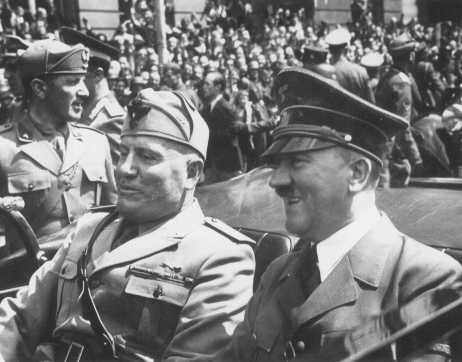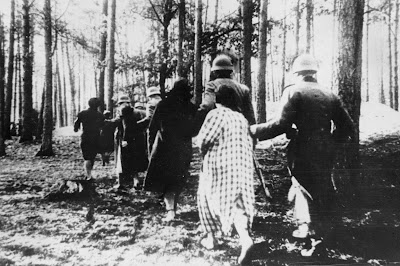Major Alliances during World War II
There were two major alliances during World War II: the Axis and the Allies.
The three principal partners in the Axis alliance were Germany, Italy, and Japan. These three countries recognized German domination over most of continental Europe; Italian domination over the Mediterranean Sea; and Japanese domination over East Asia and the Pacific.
The Allied Powers were led by Great Britain, the United States, and the Soviet

Axis leaders Adolf Hitler and Italian prime minister Benito Mussolini meet in Munich, Germany, 1940.
— National Archives and Records Administration, College Park, Md.
Formation of the Axis Alliance
Although the Axis partners never developed institutions to coordinate foreign or military policy as the Allies did, the Axis partners had two common interests:
1) territorial expansion and foundation of empires based on military conquest and the overthrow of the post-World War I international order; and
2) the destruction or neutralization of Soviet Communism.
On November 1, 1936, Germany and Italy, reflecting their common interest in destabilizing the European order, announced a Rome-Berlin Axis one week after signing a treaty of friendship. Nearly a month later, on November 25, 1936, Nazi Germany and Imperial Japan signed the so-called Anti-Comintern Pact directed at the Soviet Union. Italy joined the Anti-Comintern Pact on November 6, 1937. On May 22, 1939, Germany and Italy signed the so-called Pact of Steel, formalizing the Axis alliance with military provisions. Finally, on September 27, 1940, Germany, Italy, and Japan signed the Tripartite Pact, which became known as the Axis alliance.
Preceding Conflicts
Even before the Tripartite Pact, two of the three Axis powers had initiated conflicts that would become theaters of war in World War II. On July 7, 1937, Japan invaded China to initiate the war in the Pacific. The German invasion of Poland on September 1, 1939, unleashed the European war. Italy entered World War II on the Axis side on June 10, 1940, as the defeat of France became apparent.
Germany Pressures other States to Join the Axis
In July 1940, just weeks after the defeat of France, Hitler decided that Nazi Germany would attack the Soviet Union the following spring. In order to secure raw materials, transit rights for German troops, and troop contributions for the invasion from sympathetic powers, Germany began to cajole and pressure the southeast European states to join the Axis. Nazi Germany offered economic aid to Slovakia and military protection and Soviet territory to Romania, while warning Hungary that recent German support for Hungarian annexations of Czechoslovak and Romanian territory might change to the benefit of Slovakia and Romania.
Italy’s failed effort to conquer Greece in the late autumn and winter of 1940-1941 exacerbated German concerns about securing their southeastern flank in the Balkans. Greek entry into the war and victories in northern Greece and Albania allowed the British to open a Balkan front against the Axis in Greece that might threaten Romania’s oil fields, which were vital to Nazi Germany’s invasion plans. To subdue Greece and move the British off the European mainland, Nazi Germany now required troop transport through Yugoslavia and Bulgaria.
Hungary
After the Italo-Greek front opened on October 28, 1940, German pressure on Hungary and the Balkan States intensified. Hoping for preferential economic treatment, mindful of recent German support for annexation of northern Transylvania, and eager for future Axis support for acquiring the remainder of Transylvania, Hungary joined the Axis on November 20, 1940.
After the Italo-Greek front opened on October 28, 1940, German pressure on Hungary and the Balkan States intensified. Hoping for preferential economic treatment, mindful of recent German support for annexation of northern Transylvania, and eager for future Axis support for acquiring the remainder of Transylvania, Hungary joined the Axis on November 20, 1940.
Romania
Having already requested and received a German military mission in October 1940, Romania joined on November 23, 1940. The Romanians hoped that loyal support for a German invasion of the Soviet Union and faithful oil deliveries would destroy the Soviet threat, return the provinces annexed by the Soviet Union in June 1940, and win German support for the return of northern Transylvania.
Having already requested and received a German military mission in October 1940, Romania joined on November 23, 1940. The Romanians hoped that loyal support for a German invasion of the Soviet Union and faithful oil deliveries would destroy the Soviet threat, return the provinces annexed by the Soviet Union in June 1940, and win German support for the return of northern Transylvania.
Slovakia
Both politically and economically dependent on Germany for its very existence as an “independent” state, Slovakia followed suit on November 24.
Both politically and economically dependent on Germany for its very existence as an “independent” state, Slovakia followed suit on November 24.
Bulgaria
Bulgaria, whose leaders were reluctant to get involved in a war with the Soviet Union, and Yugoslavia, which was nominally an ally of Greece, stalled, resisting German pressure. After the Germans offered Greek territory in Thrace and exempted it from participation in the invasion of the Soviet Union, Bulgaria joined the Axis on March 1, 1941.
Bulgaria, whose leaders were reluctant to get involved in a war with the Soviet Union, and Yugoslavia, which was nominally an ally of Greece, stalled, resisting German pressure. After the Germans offered Greek territory in Thrace and exempted it from participation in the invasion of the Soviet Union, Bulgaria joined the Axis on March 1, 1941.
Yugoslavia
When the Germans agreed to settle for Yugoslav neutrality in the war against Greece, without demanding transit rights for Axis troops, Yugoslavia reluctantly joined the Axis on March 25, 1941. Two days later, Serbian military officers overthrew the government that had signed the Tripartite Pact.
When the Germans agreed to settle for Yugoslav neutrality in the war against Greece, without demanding transit rights for Axis troops, Yugoslavia reluctantly joined the Axis on March 25, 1941. Two days later, Serbian military officers overthrew the government that had signed the Tripartite Pact.
Independent State of Croatia
After the subsequent invasion and dismemberment of Yugoslavia by Germany, Italy, Hungary, and Bulgaria in April, the newly established and so-called Independent State of Croatia joined the Axis on June 15, 1941.
After the subsequent invasion and dismemberment of Yugoslavia by Germany, Italy, Hungary, and Bulgaria in April, the newly established and so-called Independent State of Croatia joined the Axis on June 15, 1941.
Finland
On June 26, 1941, four days after the Axis invasion of the Soviet Union, Finland, seeking to regain territory lost during the 1939-1940 Winter War, entered the war against the USSR as a “co-belligerent.” Finland never signed the Tripartite Pact.
On June 26, 1941, four days after the Axis invasion of the Soviet Union, Finland, seeking to regain territory lost during the 1939-1940 Winter War, entered the war against the USSR as a “co-belligerent.” Finland never signed the Tripartite Pact.
After Japan’s surprise attack on the United States fleet anchored at Pearl Harbor in Hawaii on December 7, 1941, and the declaration of war on the United States by Germany and the European Axis powers within a week, the Atlantic and Pacific wars became a truly world war.
Allied Victory
The Allied Powers, led by Great Britain, the United States, and the Soviet Union, defeated the Axis in World War II.
Italy
Italy was the first Axis partner to give up: it surrendered to the Allies on September 8, 1943, six weeks after leaders of the Italian Fascist Party deposed Fascist leader and Italian dictator Benito Mussolini.
Italy was the first Axis partner to give up: it surrendered to the Allies on September 8, 1943, six weeks after leaders of the Italian Fascist Party deposed Fascist leader and Italian dictator Benito Mussolini.
Romania
On August 23, 1944, following the overthrow of dictator Marshal Ion Antonescu, Romania switched sides: Romanian troops fought alongside Soviet troops for the remainder of the war.
On August 23, 1944, following the overthrow of dictator Marshal Ion Antonescu, Romania switched sides: Romanian troops fought alongside Soviet troops for the remainder of the war.
Bulgaria
After the Soviets rejected its offer of an armistice, Bulgaria surrendered on September 8, 1944, as the Communist-led Fatherland Front seized power from the Axis government in a coup and then declared war on Nazi Germany.
After the Soviets rejected its offer of an armistice, Bulgaria surrendered on September 8, 1944, as the Communist-led Fatherland Front seized power from the Axis government in a coup and then declared war on Nazi Germany.
Finland
On September 19, 1944, Finland signed an armistice with the Soviet Union.
On September 19, 1944, Finland signed an armistice with the Soviet Union.
Hungary
The German occupation of Hungary in March 1944 succeeded in its primary purpose: to prevent the Hungarian leaders from deserting the Axis as the Romanians would later do. Hungary never surrendered; the war ended for Hungary only when Soviet troops drove the last pro-Axis Hungarian troops and police units and the members of the Arrow Cross government across Hungary’s western border into Austria in early April 1945.
The German occupation of Hungary in March 1944 succeeded in its primary purpose: to prevent the Hungarian leaders from deserting the Axis as the Romanians would later do. Hungary never surrendered; the war ended for Hungary only when Soviet troops drove the last pro-Axis Hungarian troops and police units and the members of the Arrow Cross government across Hungary’s western border into Austria in early April 1945.
Slovakia
Slovakia, which German troops occupied in the summer of 1944 to suppress the Slovak uprising, remained in the Axis as a puppet state until the Soviets captured the capital, Bratislava, in early April 1945.
Slovakia, which German troops occupied in the summer of 1944 to suppress the Slovak uprising, remained in the Axis as a puppet state until the Soviets captured the capital, Bratislava, in early April 1945.
Croatia
Fanatical remnants of the Croat Ustasa remained in Croatia until Tito’s Partisans captured or drove them across the border into German-occupied Slovenia and Austria itself in the last days of April 1945.
Fanatical remnants of the Croat Ustasa remained in Croatia until Tito’s Partisans captured or drove them across the border into German-occupied Slovenia and Austria itself in the last days of April 1945.
Japan
On May 7, 1945, seven days after Hitler committed suicide, Nazi Germany surrendered unconditionally to the Allies. Japan fought on alone, surrendering formally on September 2, 1945.
On May 7, 1945, seven days after Hitler committed suicide, Nazi Germany surrendered unconditionally to the Allies. Japan fought on alone, surrendering formally on September 2, 1945.












